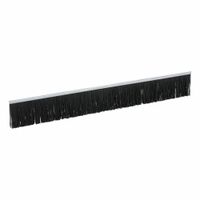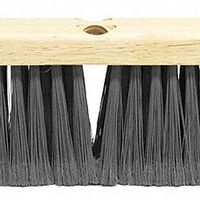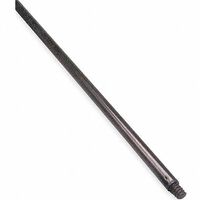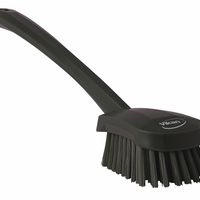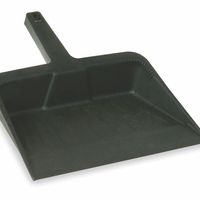Call +(254) 703 030 000 / 751 483 999 / 721 704 777
- Home
- Cleaning And Janitorial
- Cleaning Supplies
- Brushes Brooms Dust Pans
.....Read More
Frequently Asked Questions
What are the best types of bristles for different cleaning tasks?
For different cleaning tasks, selecting the right type of bristles is crucial for efficiency and effectiveness:
1. **Soft Bristles**: Ideal for delicate surfaces that can scratch easily, such as glass, mirrors, and polished wood. They are also suitable for dusting tasks, as they can trap dust without scattering it.
2. **Medium Bristles**: These are versatile and can be used for general cleaning tasks. They work well on surfaces like tile, countertops, and walls, providing a balance between gentle cleaning and effective dirt removal.
3. **Hard Bristles**: Best for tough cleaning jobs that require scrubbing, such as removing grime from concrete, brick, or outdoor surfaces. They are also effective for cleaning grills, ovens, and other areas with stubborn dirt.
4. **Rubber Bristles**: Excellent for pet hair removal from carpets and upholstery. They create static electricity that attracts hair and lint, making them effective for cleaning up after pets.
5. **Nylon Bristles**: Durable and resistant to wear, making them suitable for both wet and dry cleaning tasks. They are often used in kitchen brushes for scrubbing pots and pans.
6. **Brass Bristles**: Used for cleaning metal surfaces without causing damage. They are effective for removing rust and corrosion from tools and machinery.
7. **Stainless Steel Bristles**: Ideal for heavy-duty cleaning tasks, such as removing paint or rust from metal surfaces. They are highly durable and resistant to corrosion.
8. **Natural Bristles**: Made from materials like horsehair or boar bristles, they are gentle and suitable for cleaning delicate surfaces and applying wax or polish.
Choosing the right bristle type ensures that cleaning tasks are performed efficiently without damaging the surfaces being cleaned.
How do I choose the right broom for indoor vs. outdoor use?
To choose the right broom for indoor vs. outdoor use, consider the following factors:
1. **Bristle Material**:
- **Indoor Brooms**: Opt for soft, synthetic bristles like nylon or microfiber. These materials are gentle on indoor surfaces and effective at picking up fine dust and debris.
- **Outdoor Brooms**: Choose stiff, durable bristles made from materials like natural fibers (e.g., corn or palmyra) or heavy-duty synthetics. These can handle rough surfaces and larger debris.
2. **Bristle Stiffness**:
- **Indoor Brooms**: Soft to medium stiffness is ideal for smooth surfaces like hardwood, tile, or laminate, ensuring no scratches.
- **Outdoor Brooms**: Stiff bristles are necessary to sweep rough surfaces like concrete, asphalt, or brick.
3. **Broom Head Design**:
- **Indoor Brooms**: Angled broom heads are effective for reaching corners and tight spaces.
- **Outdoor Brooms**: Wide, flat broom heads cover more area and are efficient for large spaces.
4. **Handle Length and Material**:
- **Indoor Brooms**: A lightweight handle, often made of aluminum or plastic, is easier to maneuver indoors.
- **Outdoor Brooms**: A longer, sturdier handle, possibly made of wood or metal, provides better leverage for heavy-duty sweeping.
5. **Size and Weight**:
- **Indoor Brooms**: Compact and lightweight for easy storage and use in confined spaces.
- **Outdoor Brooms**: Larger and heavier to withstand outdoor conditions and cover more ground.
6. **Special Features**:
- **Indoor Brooms**: Consider brooms with dustpans or rubber edges for efficient cleaning.
- **Outdoor Brooms**: Look for brooms with scrapers or squeegees for tackling tough debris or wet surfaces.
By evaluating these factors, you can select brooms that are specifically suited to the demands of indoor and outdoor cleaning tasks.
What is the best way to clean and maintain brushes and brooms?
To clean and maintain brushes and brooms effectively, follow these steps:
1. **Remove Debris**: After each use, remove any trapped debris, hair, or dust from the bristles using a comb or your fingers. This prevents buildup and maintains effectiveness.
2. **Washing**: For synthetic bristles, fill a bucket with warm water and add a few drops of mild detergent. Swish the bristles in the soapy water, then rinse thoroughly with clean water. For natural bristles, use lukewarm water to avoid damage.
3. **Disinfecting**: Occasionally, disinfect the bristles by soaking them in a solution of one part vinegar to three parts water for 15 minutes. Rinse well afterward.
4. **Drying**: Shake off excess water and hang the brush or broom upside down to dry. This prevents water from seeping into the handle, which can cause damage or mold growth.
5. **Storage**: Store brushes and brooms in a dry, cool place. Hang them or keep them bristle-side up to maintain their shape and prevent bending.
6. **Handle Care**: Wipe down handles with a damp cloth to remove dirt and grime. For wooden handles, occasionally apply a wood conditioner to prevent drying and cracking.
7. **Regular Inspection**: Check for loose bristles or damage. Replace brushes or brooms when they become worn out or ineffective.
By following these steps, you can extend the life of your cleaning tools and ensure they remain effective for future use.
How do I properly dispose of debris collected with a dust pan?
To properly dispose of debris collected with a dustpan, follow these steps:
1. **Assess the Debris**: Determine the type of debris collected. It could include dust, dirt, small trash items, or broken glass. Identifying the type of debris helps in deciding the disposal method.
2. **Use a Trash Bag or Bin**: For general dust and dirt, empty the dustpan into a trash bag or bin. Ensure the bag is sturdy enough to hold the debris without tearing.
3. **Separate Recyclables**: If the debris includes recyclable materials like paper or small plastic items, separate them from the non-recyclable waste. Place recyclables in the appropriate recycling bin.
4. **Handle Hazardous Materials Carefully**: If the debris contains hazardous materials like broken glass or sharp objects, wrap them in newspaper or place them in a puncture-proof container before disposal. Label the container if necessary to alert waste handlers.
5. **Compost Organic Waste**: If the debris includes organic materials like leaves or small plant matter, consider adding them to a compost bin if available.
6. **Seal the Bag**: Once all debris is in the trash bag, seal it tightly to prevent spillage and odors. Use a twist tie or knot to secure the bag.
7. **Dispose of the Bag**: Place the sealed bag in your outdoor trash bin for regular waste collection. Ensure the bin lid is closed to prevent animals from accessing the contents.
8. **Clean the Dustpan**: After disposing of the debris, clean the dustpan with soap and water to remove any remaining dirt or residue. Dry it thoroughly before storing.
By following these steps, you ensure safe and environmentally responsible disposal of debris collected with a dustpan.
What are the benefits of using a dust pan with a long handle?
Using a dustpan with a long handle offers several benefits that enhance convenience and efficiency in cleaning tasks. Firstly, it significantly reduces the need for bending or stooping, which is particularly beneficial for individuals with back problems or mobility issues. This ergonomic advantage minimizes strain on the back and knees, promoting better posture and reducing the risk of injury during cleaning.
Secondly, a long-handled dustpan allows for quicker and more efficient cleaning. It enables users to cover larger areas without frequent repositioning, making it ideal for cleaning expansive spaces like hallways or large rooms. The extended reach also facilitates the collection of debris from under furniture or in hard-to-reach areas without the need to move heavy objects.
Additionally, using a dustpan with a long handle can improve hygiene. By maintaining an upright position, users avoid close contact with dust and debris, reducing the risk of inhaling allergens or coming into contact with dirt. This is particularly advantageous in environments where cleanliness is paramount, such as hospitals or food preparation areas.
Moreover, long-handled dustpans often come with features like rubber edges that ensure a better seal with the floor, preventing dust from escaping underneath. Some models also include a built-in comb to clean broom bristles, enhancing the overall cleaning process.
Finally, these dustpans are versatile and can be used in various settings, from homes to commercial spaces, making them a practical addition to any cleaning toolkit. Their design caters to a wide range of users, from professional cleaners to everyday homeowners, offering a blend of comfort, efficiency, and hygiene.
How do I replace the head or handle on a broom or brush?
1. **Identify the Type of Broom or Brush**: Determine if the broom or brush has a screw-on, clip-on, or push-fit mechanism.
2. **Remove the Old Head or Handle**:
- **Screw-On**: Twist the head or handle counterclockwise to unscrew it.
- **Clip-On**: Press the clips or tabs to release the head or handle.
- **Push-Fit**: Pull the head or handle straight off with a firm grip.
3. **Select a Compatible Replacement**: Ensure the new head or handle matches the attachment mechanism and size of the original.
4. **Attach the New Head or Handle**:
- **Screw-On**: Align the threads and twist clockwise until secure.
- **Clip-On**: Align the clips or tabs and press until they click into place.
- **Push-Fit**: Push the head or handle firmly onto the shaft until it fits snugly.
5. **Test for Stability**: Shake the broom or brush gently to ensure the new head or handle is securely attached.
6. **Adjust for Comfort**: If the handle is adjustable, set it to a comfortable length for use.
7. **Maintenance Tips**: Regularly check the attachment for wear and tear, and replace as needed to maintain efficiency.
What are the differences between synthetic and natural bristles?
Synthetic bristles are typically made from materials like nylon, polyester, or Taklon. They are designed to mimic the properties of natural bristles but offer distinct advantages. Synthetic bristles are generally more durable and less prone to damage from makeup products and cleaning agents. They are non-porous, which means they do not absorb makeup or oils, making them easier to clean and more hygienic. Additionally, synthetic bristles are often more affordable and are a preferred choice for those seeking vegan or cruelty-free options.
Natural bristles, on the other hand, are made from animal hair, such as sable, squirrel, goat, or pony. These bristles are known for their softness and ability to pick up and distribute powder products effectively due to their porous nature. Natural bristles tend to hold onto product better, providing a more seamless application, especially for powder-based cosmetics. However, they require more careful maintenance and cleaning to prevent damage and maintain their quality. Natural bristles can be more expensive and may not be suitable for liquid or cream products, as they can absorb these formulations, leading to product wastage and potential bacterial growth.
In summary, the choice between synthetic and natural bristles depends on personal preferences, ethical considerations, and the type of makeup products being used. Synthetic bristles offer durability, ease of maintenance, and are suitable for a wide range of products, while natural bristles excel in applying powder products with a softer, more natural finish.
